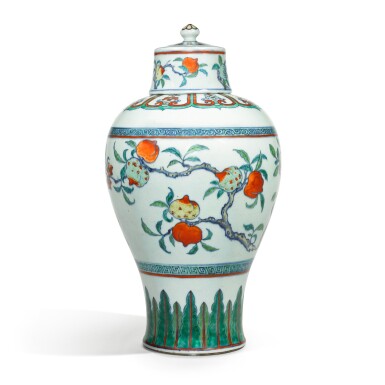
A rare doucai 'sanduo' meiping and cover, Qing dynasty, Yongzheng/Qianlong period | 清雍正/乾隆 闘彩三多紋梅瓶連蓋
No reserve
Auction Closed
November 1, 04:18 PM GMT
Estimate
60,000 - 80,000 GBP
Lot Details
Description
A rare doucai 'sanduo' meiping and cover
Qing dynasty, Yongzheng/Qianlong period
清雍正/乾隆 闘彩三多紋梅瓶連蓋
(2)
Height 38.2 cm, 15 in.
Collection of The Right Honourable. The Countess of Craven (1877-1961).
Sotheby's London, 8th December 1964, lot 57.
Collection of Dr Wou Kiuan (1910-1997).
Wou Lien-Pai Museum, 1968-present, coll. no. Q.8.32.
Craven伯爵夫人(1877-1961)收藏
倫敦蘇富比1964年12月8日,編號57
吳權博士 (1910-1997) 收藏
吳蓮伯博物院,1968年至今,編號Q.8.32
China Without Dragons: Rare Pieces from Oriental Ceramic Society Members, The Oriental Ceramic Society, London, 2016, cat. no. 198.
《龍隱: 英國東方陶瓷學會會員珍稀藏品展》,東方陶瓷學會,倫敦,2016年,編號198
Rose Kerr et al., Chinese Antiquities from the Wou Kiuan Collection. Wou Lien-Pai Museum, Hong Kong, 2011, pl. 152.
柯玫瑰等,《Chinese Antiquities from the Wou Kiuan Collection. Wou Lien-Pai Museum》,香港,2011年,圖版152
This rare covered meiping is directly inspired by an early Ming dynasty (1368-1644) design, but it is unusual to find one with fruit branches painted in doucai style, and no closely related example appears to have been published. This meiping echoes blue-and-white prototypes such as a Xuande period (1426-35) example adorned with large fruit sprays at the centre, similarly painted with plantain leaves rising from the foot and the shoulder decorated with stylised lotus lappets, but lacking a cover, preserved in the Palace Museum, Beijing, accession no. gu-143565.
The motif on this vessel is highly auspicious and is known as sanduo, literally ‘three plenties’ or ‘three abundances’. The idea originates from the main Daoist text, Zhuangzi, of the Warring States period (475-211 BC), which records a quote from an official that ‘long life, riches, and many sons are what men wish for’. At least from the late Ming dynasty, these three blessings have been symbolically rendered by groups of the three fruits peach, Buddha’s Hand citron and pomegranate. In China, peaches have a long history of being associated with longevity and immortality. Buddha’s Hand citron (fo shou) is a pun for ‘riches’ (fu) and ‘blessings' (fu) in Chinese. The pomegranate, usually depicted split open and revealing its multiple seeds, represents the wish for many offspring.
For contemporary examples with the motif of three fruits, but rendered in the form of sprays instead of branches and decorated in other palettes, see a blue-and-white sanduo meiping and cover preserved in the National Palace Museum, Taipei (accession no. gu-ci-9184); another without a cover, preserved in the Palace Museum, Beijing (accession no. gu-159033); and a copper-red decorated meiping of Qianlong mark and period, lacking a cover and the two circular bands on the body, also in the Palace Museum, Beijing, accession no. xin-96001.
You May Also Like










